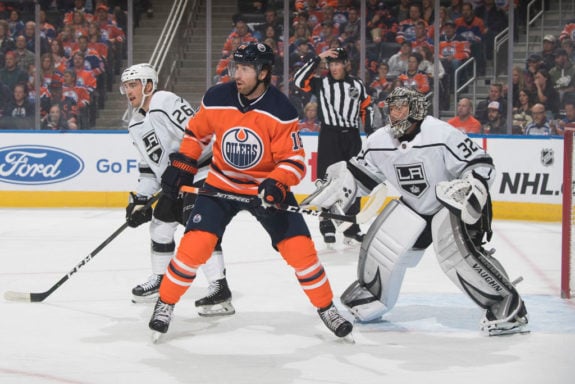
 Nolan Jensen
The Hockey Writers
Nolan Jensen
The Hockey Writers
42
Reads
0
Comments
Oilers Need to Fix Their Salary Cap Situation…Here’s How
It was projected that the NHL’s salary cap would increase this offseason from $81.5 million to the likes of $84-$88 million (per Eric Francis of Sportsnet), but an unexpected, unprecedented set of circumstances have altered those logistics. Now, with a reported “flat cap,” teams, such as the Edmonton Oilers, who were potentially operating with the belief of an increased cap, are going to have to make some difficult decisions sooner rather than later.
How should the Oilers, who already have $70.9 million of their $81.5 million in cap space accounted for in the 2020-21 season, deal with their finances now and moving forward?
Related: Oilers History – The Return of Grant Fuhr
By no means is Edmonton in dire straits like some of their counterparts (Tampa Bay Lightning, Arizona Coyotes, Toronto Maple Leafs, and St. Louis Blues, to name a few) in terms of operating close to the cap in the immediate future, but their situation will only get more challenging once the contracts Ryan Nugent-Hopkins (UFA), Kailer Yamamoto (RFA), and Adam Larsson (UFA), amongst others, expire at the end of the 2020-21 season.

The contracts of Andreas Athanasiou (RFA), Ethan Bear (RFA), William Lagesson (RFA), Matt Benning (RFA), Mike Green (RFA), Patrick Russell (UFA), Tyler Ennis (UFA), and Riley Sheahan (UFA) all need addressing this offseason as well, with future implications in mind.
Playing the Buyout Market
Oilers fans are all-too-familiar with the cap ramifications of the buyout market. This, after all, is a team that paid Andrej Sekera, Eric Gryba, and Benoit Pouliot to not dress in an Edmonton uniform this season. Likewise, they also retained the salaries – be it at a smaller figure – of Milan Lucic and Sam Gagner.
Obviously, the NHL gifting every team across the league the luxury of a compliance buyout – teams were awarded two compliance buyouts after the 2012 lockout – would help the cause. Then, the Oilers could “buyout” either James Neal or Kris Russell, maybe even both, without the harshness of salary-cap consequences.
But, if relief in the form of a compliance buyout isn’t awarded to NHL teams, the Oilers should still seriously entertain the idea of parting ways with Neal – though his presence will still be felt logistically.
The Neal/Lucic deal last summer was a positive one for Edmonton; Neal played well this season, especially on the man advantage. He netted 19 goals this season, including 12 on the power play. He’s still a skilled, savvy veteran that can pick his spots which obviously complements the playmaking acumen of Leon Drasaitl and Connor McDavid. Both players finished first and second in assists, respectively, this season.

However, entering next season he will be 33, Father time is looming around the corner, which begs the question: will his contributions be vital in determining what levels of success the Oilers do/don’t have down the line? Or can you essentially throw a plug-and-play forward on a power play, or top-two line, with McDavid/Drasaitl, and reach synonymous or near-synonymous levels of production like Neal had this past season?
Neal never really had a permanent home on any line this year, raising questions about his $5.75 million annual cap hit now until the end of the 2022-23 season.
Related: Darryl Sittler – Toronto Maple Leafs Legend
If a traditional buyout is Neal’s destiny in Edmonton, the Oilers would save, on average, $3.83 million per season. The flip side to that coin is they would pay $1.916 million annually until the conclusion of the 2025-26 season. An additional three years on the books would be the long-term implications of a buyout, but they would save approximately $11.5 million, holistically, in the next three seasons (according to Puckpedia)
Trade
Now, another avenue that can be ventured to free up some cap space is via trade. Immediately, one Oiler stands out in particular: Kris Russell.
Russell’s cap hit comes with a $4 million price tag, and though he’s scored just eight goals in his four-year tenure with the Oilers and his skill set lacks versatility, his presence as a veteran in the locker room compounded with toughness and willing to sacrifice his body to deter quality scoring chances for the opposition still has value – be it moderate or significant.
Shedding Russell’s final year off the books would provide the Oilers with a tad more flexibility before Holland is forced to metaphorically walk the tightrope and perform his best display of cap gymnastics.

It’s also notable that Russell’s modified no-trade clause expands from 10 to 15 teams this July, increasing the possibility of a trade to actually occur.
Another potential trade piece lies in the form of Alex Chiasson, who comes at a cap hit of $2.15 million next season. Chiasson’s production plummeted this season; he scored 11 goals (compared to his 22 in the 2018-19 season), and registered just 24 points (38 last season) despite playing in only eight fewer games than he did a year prior.
The logistics of his contract doesn’t necessarily put many teams across the league in a cap stranglehold, and he still has value as a bottom-six forward that can provide some secondary offense. Getting his deal off the books would mean money spent elsewhere, and in this case, on some of the youth that showed real upside this year.
Returning Faces
Not retaining the rights of Athanasiou would be a tough pill to swallow for Ken Holland, who recently gave up two second-round draft selections to acquire the 26-year-old.
Though the follow-up to his 30-goal campaign in the 2018-19 season has been relatively disappointing, I don’t see a world where Holland decides to cut his losses and let him walk this offseason.
Re-signing or locking in contracts for the likes of Bear, Athanasiou, and Benning, all RFA’s this offseason, makes sense from a personnel standpoint. However, retaining the rights to those three players would probably cost north of $7.5 million. Athanasiou getting a lion’s share of that figure, with Bear and Benning likely combining for an upwards of $3.5-$4 million.

This means, if compliance buyouts aren’t rewarded or the Oilers decide against walking down the oh-so-familiar path of a traditional buyout, the team would have a hair over $3 million, and that figure isn’t exactly set in stone, to also re-sign UFA’s like Sheahan and Ennis.
Related: Colorado Avalanche Franchise Jersey History
So, to allow for roster continuity and a semblance of flexibility in terms of cap space, buying out Neal might be the Oilers’ best option. He acted as a beneficiary of McDavid, Drasaitl, Nugent-Hopkins’ playmaking all season. Likewise, with Yamamoto on the rise and no real decrease in power-play effectiveness with Neal out of the line-up, the team could survive without his services.
This organization and fan base is no stronger to the buyout market, and that doesn’t look like it’s going to change soon with a “flat cap” altering the team’s plans.
The post Oilers Need to Fix Their Salary Cap Situation…Here’s How appeared first on The Hockey Writers.
Popular Articles

















































 Blackhawks Chicago
Blackhawks Chicago Panthers Florida
Panthers Florida Penguins Pittsburgh
Penguins Pittsburgh Rangers New York
Rangers New York Avalanche Colorado
Avalanche Colorado Kings Los Angeles
Kings Los Angeles Maple Leafs Toronto
Maple Leafs Toronto Bruins Boston
Bruins Boston Capitals Washington
Capitals Washington Flames Calgary
Flames Calgary Oilers Edmonton
Oilers Edmonton Golden Knights Vegas
Golden Knights Vegas Senators Ottawa
Senators Ottawa Lightning Tampa Bay
Lightning Tampa Bay Flyers Philadelphia
Flyers Philadelphia Islanders New York
Islanders New York Sabres Buffalo
Sabres Buffalo Red Wings Detroit
Red Wings Detroit Devils New Jersey
Devils New Jersey Hurricanes Carolina
Hurricanes Carolina Blue Jackets Columbus
Blue Jackets Columbus Predators Nashville
Predators Nashville Stars Dallas
Stars Dallas Jets Winnipeg
Jets Winnipeg Wild Minnesota
Wild Minnesota Blues St. Louis
Blues St. Louis Mammoth Utah
Mammoth Utah Sharks San Jose
Sharks San Jose Ducks Anaheim
Ducks Anaheim Canucks Vancouver
Canucks Vancouver






